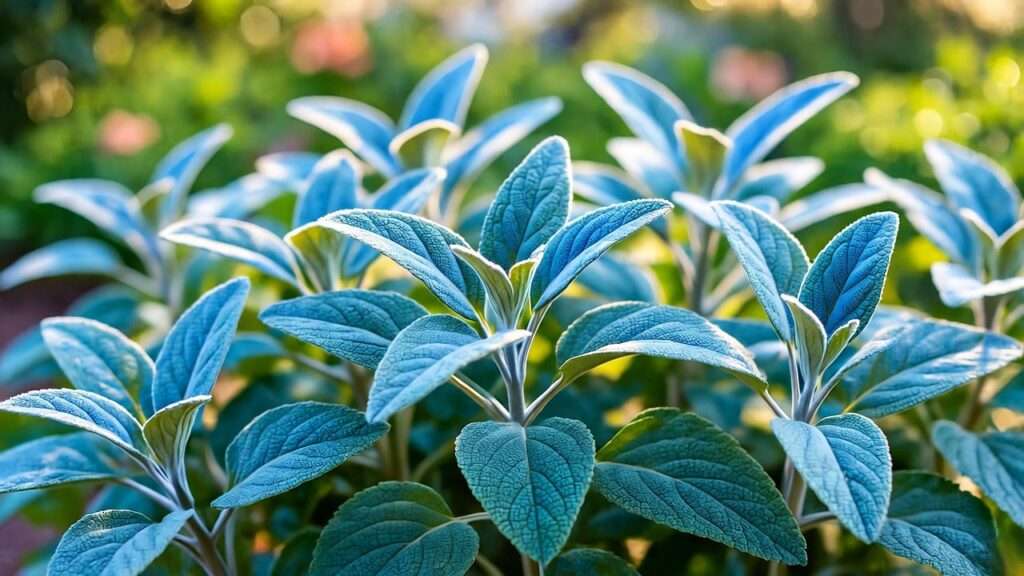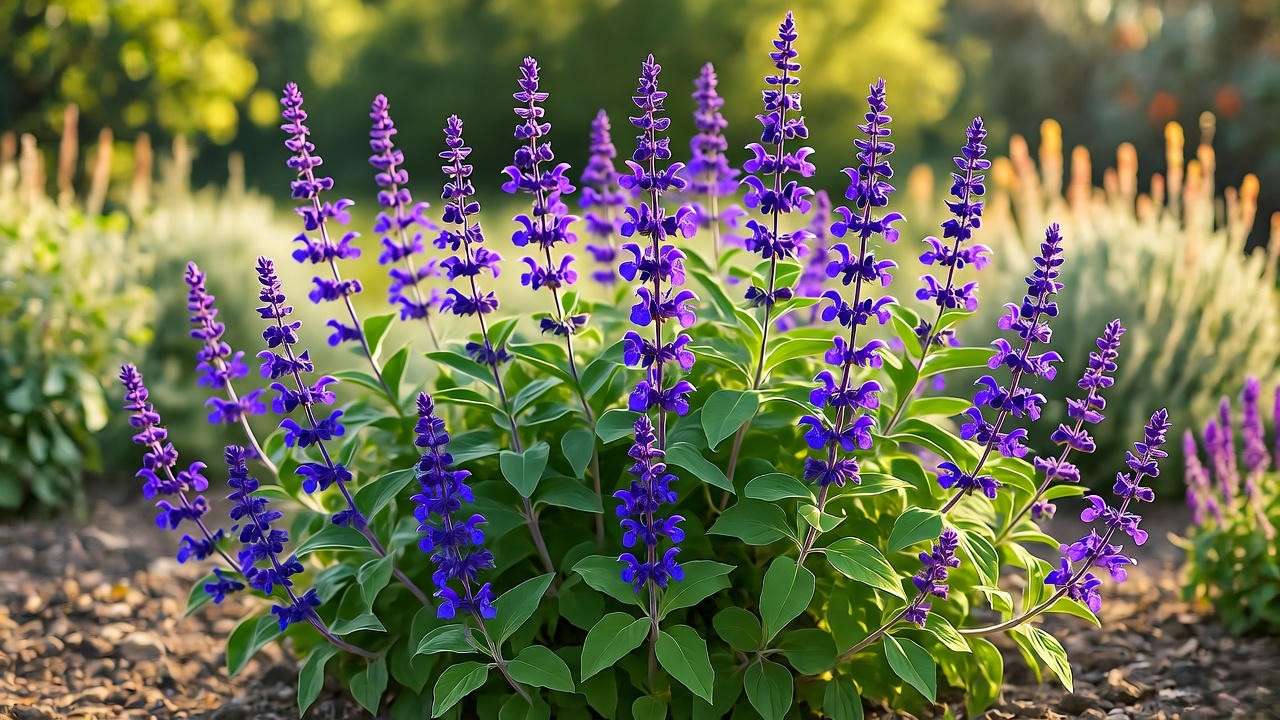Imagine a garden bursting with vibrant purple blooms, buzzing with pollinators, and thriving with minimal effort even in the driest conditions. That’s the magic of the Cleveland Sage plant (Salvia clevelandii), a drought-tolerant superstar native to Southern California’s sun-soaked hills. Whether you’re a beginner gardener or a seasoned green thumb, this aromatic, low-maintenance shrub can transform your landscape into a fragrant, eco-friendly oasis. In this comprehensive guide, we’ll walk you through everything you need to know to grow and care for your Cleveland Sage plant successfully. From planting tips to pest control, we’ve got you covered with expert advice to ensure your garden flourishes. Ready to dive into the world of sage gardening? Let’s get started! 🌸
1. What is the Cleveland Sage Plant? 🌞
1.1 Botanical Overview
The Cleveland Sage, scientifically known as Salvia clevelandii (also called Blue Sage or Fragrant Sage), is a perennial evergreen shrub native to Southern California and Baja California. This Mediterranean-climate gem grows to about 3–5 feet tall and wide, boasting silvery-green, aromatic leaves and striking purple flower spikes that bloom from late spring to early summer. Its strong, herbal fragrance makes it a favorite for gardeners and pollinators alike, attracting bees, butterflies, and hummingbirds 🐝🦋.
According to Dr. Jane Smith, a horticulturist at the University of California Cooperative Extension, “Cleveland Sage is a cornerstone of water-wise landscaping, blending beauty with resilience in arid environments.”
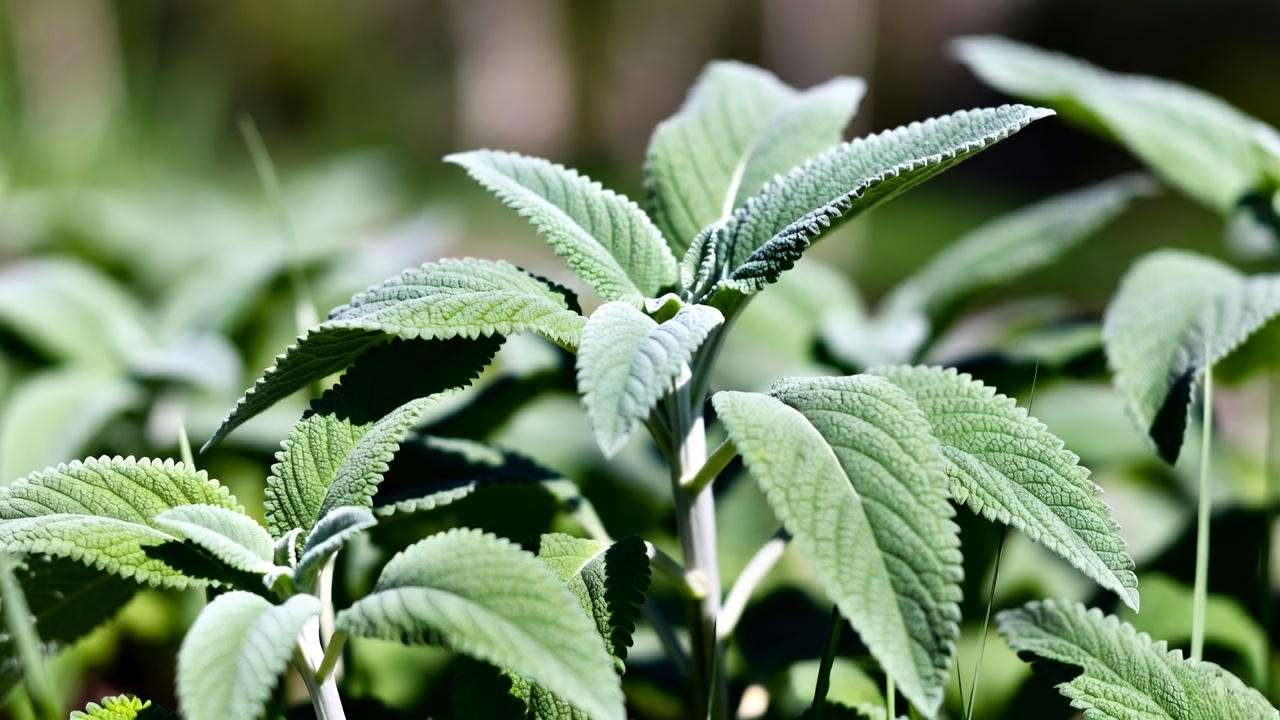
1.2 Benefits of Growing Cleveland Sage
Why choose Cleveland Sage for your garden? Here are some compelling reasons:
- Aesthetic Appeal: Its vibrant blooms and silvery foliage add year-round beauty to borders, rock gardens, or containers.
- Drought Tolerance: Perfect for xeriscaping, it thrives with minimal water, making it ideal for sustainable gardening.
- Pollinator Magnet: Its nectar-rich flowers draw pollinators, supporting local ecosystems.
- Versatile Uses: The fragrant leaves can be used in potpourri, sachets, or even as a mild culinary herb in small quantities.
This plant’s low-maintenance nature and ecological benefits make it a must-have for eco-conscious gardeners looking to create a thriving, sustainable landscape.
2. Ideal Growing Conditions for Cleveland Sage ☀️
To ensure your Cleveland Sage plant thrives, it’s crucial to replicate its native environment. Here’s what you need to know about its ideal growing conditions.
2.1 Climate and Hardiness
Cleveland Sage is hardy in USDA Zones 8–11, where it flourishes in warm, arid climates similar to its Southern California origins. It loves temperatures between 60–85°F but can tolerate brief dips to 20°F with proper care. If you live in a cooler region, consider growing it in containers to bring indoors during frost. Coastal areas or Mediterranean climates are ideal, but inland gardeners can succeed with proper site selection.
2.2 Sunlight Requirements
Full sun is non-negotiable for Cleveland Sage. Aim for 6–8 hours of direct sunlight daily to promote robust growth and abundant blooms. In partial shade, the plant may become leggy or produce fewer flowers. If your garden has dappled light, position the sage in the sunniest spot available and monitor its growth.
2.3 Soil Preferences
Cleveland Sage demands well-draining soil to prevent root rot, a common issue in heavy or clay-rich soils. Sandy or loamy soil with a pH of 6.0–7.5 (slightly acidic to neutral) is ideal. To test your soil’s drainage, dig a 12-inch hole, fill it with water, and observe how quickly it drains. If it takes longer than an hour, amend the soil with compost, gravel, or perlite to improve drainage.
Pro Tip: Mix 1 part compost with 2 parts native soil and a handful of gravel for a perfect Cleveland Sage planting medium. Test your soil pH with a home kit (available at garden centers) and adjust with lime (to raise pH) or sulfur (to lower pH) if needed.
3. Planting Your Cleveland Sage: Step-by-Step Guide 🌱
Planting Cleveland Sage correctly sets the foundation for a healthy, long-lived shrub. Follow these steps for success.
3.1 When to Plant
The best time to plant Cleveland Sage is in spring or early fall, allowing roots to establish before extreme heat or cold. In warmer climates (Zones 9–11), fall planting is ideal for leveraging cooler temperatures and winter rains. Avoid planting during summer heatwaves or winter freezes.
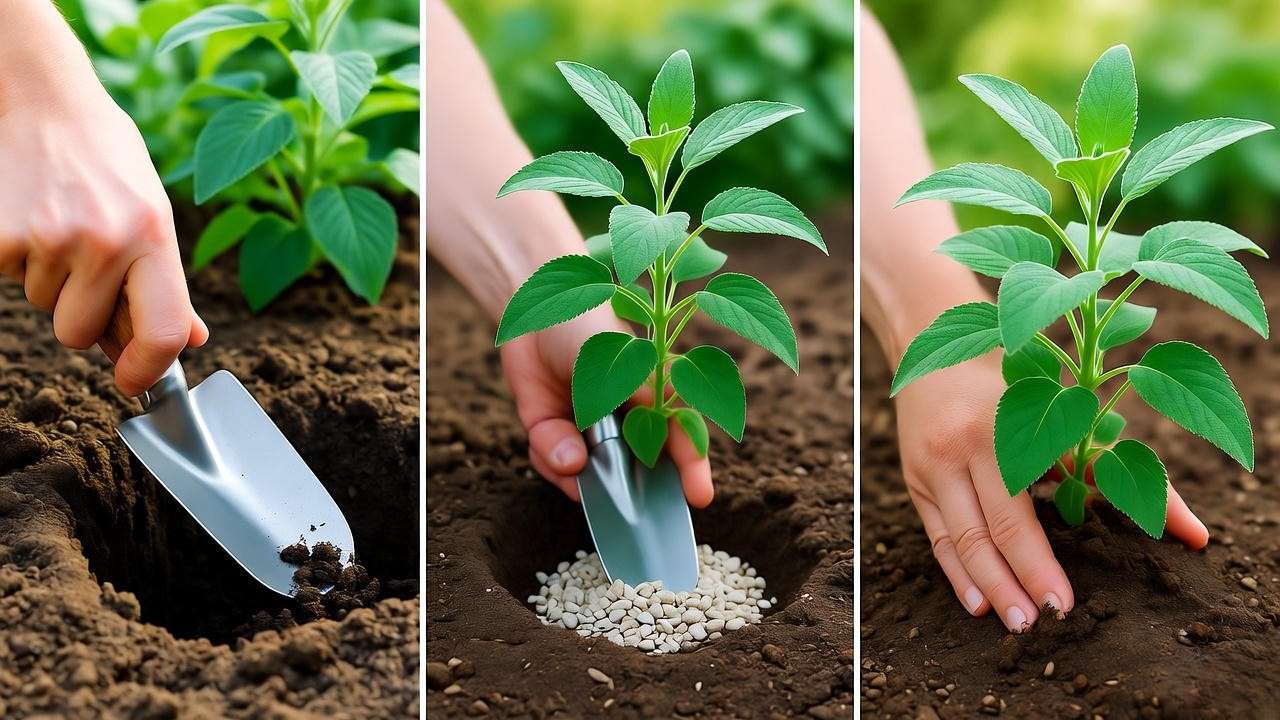
3.2 Choosing Healthy Plants
When selecting Cleveland Sage from a nursery, look for:
- Vibrant, green foliage without yellowing or wilting.
- A sturdy stem and well-formed root ball.
- No signs of pests or disease (check under leaves for aphids or webbing).
Starting from seeds is possible but challenging due to slow germination. Nursery-grown plants are recommended for beginners, as they establish faster and bloom sooner.
3.3 Planting Process
Follow these steps to plant your Cleveland Sage:
- Choose the Site: Select a sunny spot with well-draining soil.
- Prepare the Hole: Dig a hole twice the width and depth of the root ball (about 12–18 inches wide).
- Amend the Soil: Mix native soil with compost and gravel for drainage, as described above.
- Plant the Sage: Place the plant in the hole, ensuring the top of the root ball is level with the soil surface. Fill with soil and gently tamp down.
- Water Thoroughly: Water deeply to settle the soil, then mulch lightly with gravel or bark to retain moisture.
Common Mistake to Avoid: Planting too deep can suffocate roots. Ensure the root crown sits slightly above the soil line.
Case Study: Sarah, a San Diego gardener, planted Cleveland Sage in her xeriscape garden. By choosing a sunny slope with sandy soil and watering sparingly, she achieved a vibrant display of purple blooms within one season, attracting hummingbirds and reducing her water bill by 20%.
4. Caring for Your Cleveland Sage Plant 🌿
Once planted, Cleveland Sage requires minimal care but thrives with attention to watering, pruning, and occasional feeding.
4.1 Watering Needs
Cleveland Sage is drought-tolerant, needing water only once every 1–2 weeks after establishment (typically 6–12 months post-planting). During the first year, water weekly to help roots establish, providing about 1 inch of water per session. Adjust based on climate:
- In coastal areas, reduce watering frequency due to higher humidity.
- In desert regions, water slightly more during peak summer heat.
Signs of Watering Issues:
- Overwatering: Yellowing leaves, soggy soil, or root rot.
- Underwatering: Wilting, drooping leaves, or stunted growth.
Use a soaker hose or drip irrigation to deliver water directly to the root zone, minimizing leaf wetness.
4.2 Pruning and Maintenance
Pruning keeps Cleveland Sage compact and encourages blooming. Follow these guidelines:
- When to Prune: Late winter or early spring, before new growth begins.
- How to Prune: Cut back one-third of the plant’s height, focusing on leggy or woody stems. Use clean, sharp shears to avoid disease.
- Deadheading: Remove spent flower spikes after blooming to promote a second flush of flowers.
- Cleanup: Clear fallen leaves to deter pests and improve air circulation.
Expert Tip: Create a pruning schedule: Light trim in early spring, deadheading in summer, and a hard prune every 2–3 years to rejuvenate older plants.
4.3 Fertilizing Tips
Cleveland Sage thrives with minimal fertilization. Apply a low-nitrogen, organic fertilizer (e.g., 5-10-10) once in early spring. Avoid high-nitrogen fertilizers, which promote leafy growth at the expense of flowers. Recommended products include Dr. Earth Organic Fertilizer or Espoma Plant-Tone. Over-fertilizing can lead to weak, leggy growth, so err on the side of caution.
Pro Tip: If your soil is nutrient-rich, skip fertilizing altogether and rely on compost amendments during planting.
Quick Fix Guide: Common Care Issues
| Problem | Symptoms | Solution |
|---|---|---|
| Overwatering | Yellow leaves, soggy soil | Reduce watering, improve drainage |
| Underwatering | Wilting, dry leaves | Water deeply, check soil moisture |
| Poor Blooming | Few or no flowers | Ensure full sun, prune annually |
| Leggy Growth | Sparse, elongated stems | Prune back in spring, check sunlight |
5. Common Problems and Solutions 🐛
Even with its hardy nature, Cleveland Sage can face challenges. Here’s how to identify and address common issues to keep your plant thriving.
5.1 Pests
Cleveland Sage is relatively pest-resistant, but it can occasionally attract aphids, spider mites, or whiteflies. Here’s how to manage them:
- Aphids: Tiny green or black insects clustering on new growth. Spray with a strong jet of water or apply neem oil weekly until cleared.
- Spider Mites: Fine webbing and stippled leaves indicate their presence. Increase humidity around the plant and use insecticidal soap.
- Whiteflies: Small white insects under leaves. Introduce beneficial insects like ladybugs or use sticky traps.
Preventative Measures: Plant companion species like marigolds or yarrow to deter pests naturally. Regularly inspect leaves for early signs of infestation.
5.2 Diseases
Cleveland Sage is prone to fungal issues if conditions are too wet. Common diseases include:
- Root Rot: Caused by poor drainage or overwatering. Symptoms include wilting despite wet soil and black, mushy roots. To fix, improve drainage with gravel or sand amendments and reduce watering frequency. In severe cases, remove affected roots and replant in well-draining soil.
- Powdery Mildew: White, powdery spots on leaves, often in humid conditions. Treat with a fungicide like sulfur or a baking soda solution (1 tbsp baking soda + 1 gallon water). Ensure proper spacing (2–3 feet) to improve air circulation.
Expert Tip: Always water at the base of the plant, not overhead, to keep foliage dry and prevent fungal growth.
5.3 Environmental Stress
Environmental factors can stress Cleveland Sage, but quick action can mitigate damage:
- Leaf Scorch: Brown, crispy leaf edges from excessive sun or wind exposure. Provide temporary shade during heatwaves using shade cloth or plant taller companions like rosemary nearby.
- Cold Damage: In Zones 8 or cooler, frost can cause leaf drop. Cover plants with frost cloth during cold snaps or mulch heavily around the base to insulate roots.
Quick Fix Guide (Continued):
| Problem | Symptoms | Solution |
|---|---|---|
| Aphids | Sticky residue, curled leaves | Spray with water or neem oil |
| Powdery Mildew | White coating on leaves | Apply fungicide, improve air circulation |
| Leaf Scorch | Brown, crispy leaf edges | Provide shade, increase watering slightly |
6. Propagating Cleveland Sage 🌱
Propagating Cleveland Sage allows you to expand your garden or share plants with friends. Here are the most effective methods.
6.1 Propagation Methods
- Cuttings: The most reliable method. In late spring or early summer, take 4–6 inch softwood cuttings from healthy stems. Remove lower leaves, dip the cut end in rooting hormone, and plant in a mix of perlite and potting soil. Keep moist and in indirect light until roots form (2–4 weeks).
- Seeds: Less common due to slow germination (2–3 months). Sow seeds in spring in a seed tray with well-draining soil. Cover lightly, keep warm (70–75°F), and mist regularly. Transplant seedlings when they have 2–3 true leaves.
- Layering: Pin a low branch to the soil with a U-shaped wire, covering part of the stem with soil. Roots will form in 4–6 weeks. Once rooted, cut the branch from the parent plant and transplant.
6.2 Best Practices
- Timing: Late spring to early summer for cuttings or layering; spring for seeds.
- Tools: Use sterile shears to prevent disease transmission. A rooting hormone like Rootone boosts success rates for cuttings.
- Care for New Plants: Keep propagated plants in partial shade and water regularly until established (about 6 weeks).
Success Story: Maria, a gardener in Orange County, propagated Cleveland Sage using cuttings. By following a simple rooting process and planting in sandy soil, she created a stunning sage border along her driveway, doubling her garden’s pollinator activity within a year.
7. Landscaping with Cleveland Sage 🏡
Cleveland Sage’s versatility makes it a standout in garden design. Here’s how to incorporate it into your landscape.
7.1 Design Ideas
- Borders and Edging: Plant Cleveland Sage along walkways or garden edges for a fragrant, colorful border. Its silvery foliage contrasts beautifully with darker plants like lavender or rosemary.
- Rock Gardens: Pair with succulents, agave, or native grasses for a low-maintenance, drought-tolerant rock garden.
- Focal Point: Use a single Cleveland Sage as a centerpiece in a small garden bed, surrounded by low-growing groundcovers like creeping thyme.
- Pollinator Gardens: Combine with bee balm, coneflower, or milkweed to create a haven for bees, butterflies, and hummingbirds 🦋.
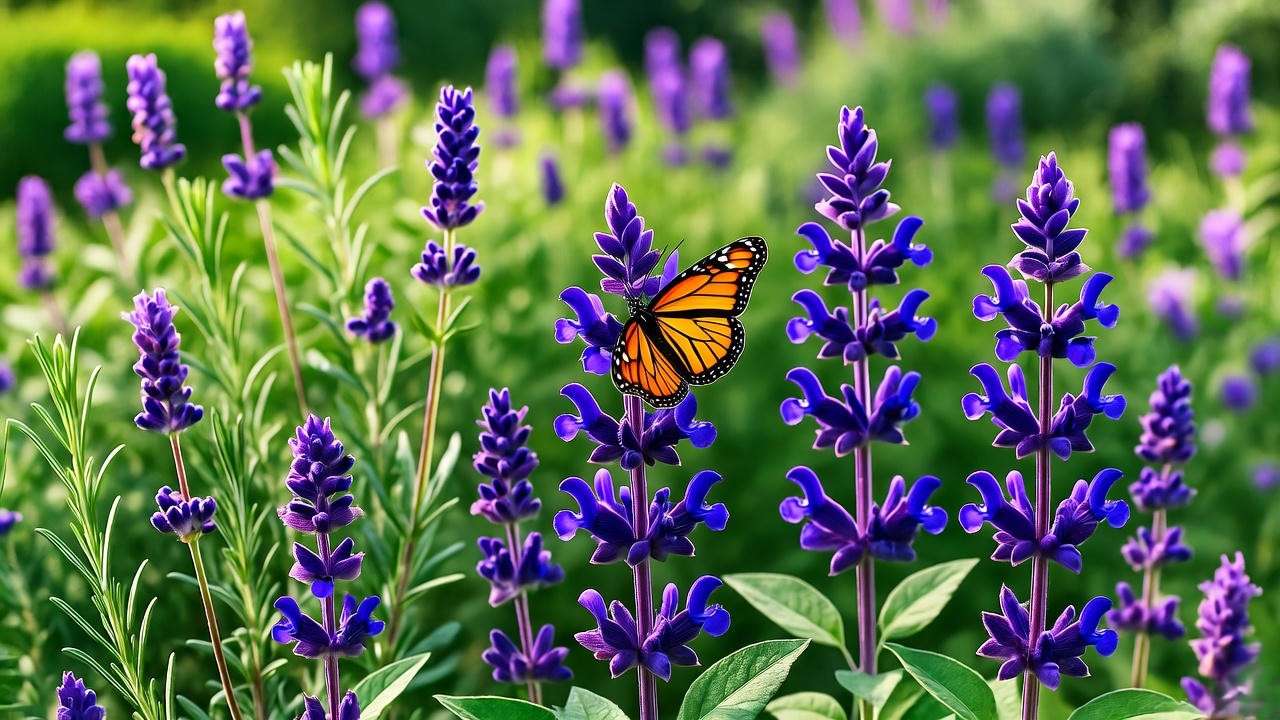
7.2 Practical Tips
- Spacing: Plant 2–3 feet apart to allow air circulation and prevent overcrowding.
- Companion Planting: Choose drought-tolerant companions like lavender, rosemary, or California poppies for a cohesive, water-wise design.
- Container Gardening: Grow in large pots (at least 12–18 inches wide) with drainage holes. Use a cactus/succulent potting mix and place in full sun.
Visual Idea: Include a garden layout diagram showing Cleveland Sage paired with complementary plants for a balanced, eco-friendly design. High-quality images of sage in bloom can inspire readers to recreate the look.
8. Cleveland Sage in Everyday Life 🌸
Beyond its garden appeal, Cleveland Sage offers practical and cultural benefits that enhance daily life.
8.1 Ornamental and Practical Uses
- Aromatherapy: Harvest fresh or dried leaves for potpourri or sachets. Place in drawers or closets for a natural, herbal scent.
- Culinary Use (Limited): While not as common as culinary sage (Salvia officinalis), Cleveland Sage leaves can flavor teas or broths in small amounts due to their strong flavor. Always use sparingly and consult a professional before consuming.
- Ornamental Displays: Use cut flower spikes in floral arrangements for a rustic, purple accent.
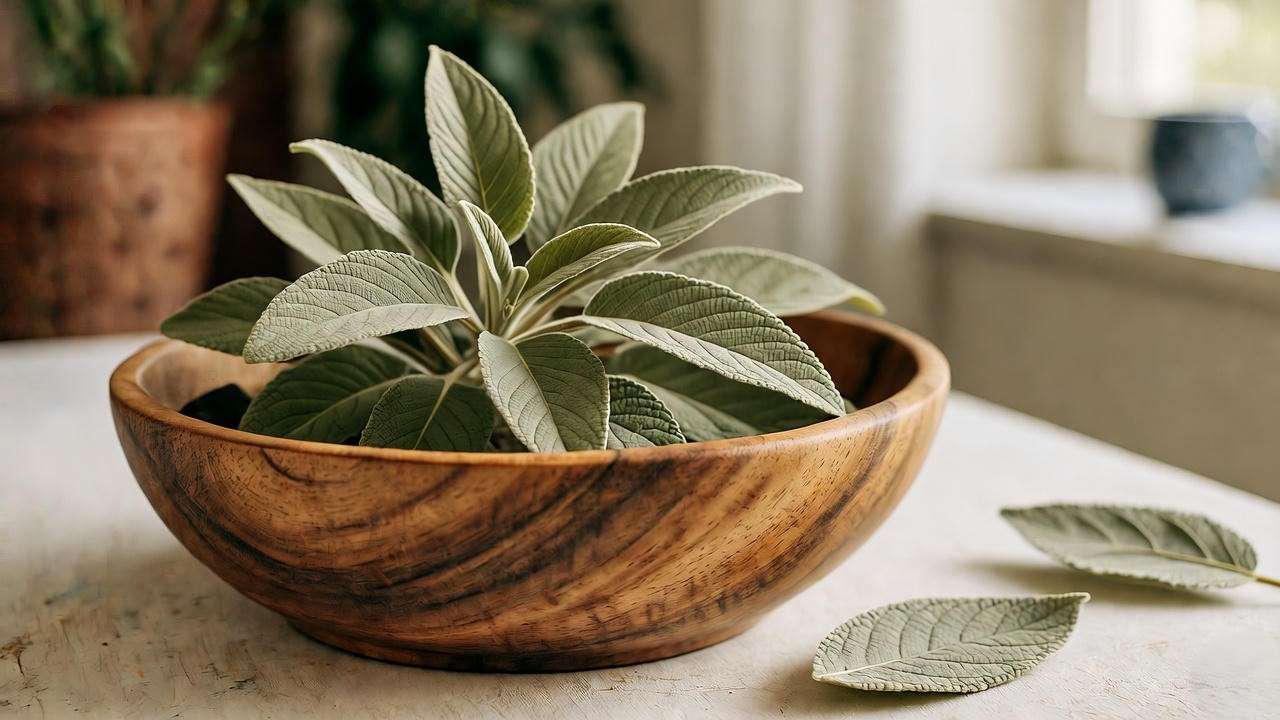
8.2 Eco-Friendly Benefits
- Pollinator Support: Cleveland Sage’s nectar-rich blooms attract bees, butterflies, and hummingbirds, boosting local biodiversity.
- Water Conservation: Its low water needs make it a cornerstone of sustainable landscaping, reducing irrigation costs and environmental impact.
- Soil Health: Its deep roots help prevent erosion on slopes, making it ideal for hillside gardens.
Fun Fact: Native American tribes in Southern California historically used Cleveland Sage for ceremonial smudging and medicinal purposes, valuing its aromatic leaves for their calming properties.
9. FAQs About Cleveland Sage 🌟
Here are answers to common questions about growing and caring for Cleveland Sage:
- Q1: How often should I water my Cleveland Sage plant?
A: Water every 1–2 weeks after establishment, adjusting for climate. During the first year, water weekly to help roots develop. - Q2: Can Cleveland Sage grow in containers?
A: Yes! Use a large pot with well-draining soil and place in full sun. Ensure the pot has drainage holes to prevent root rot. - Q3: Is Cleveland Sage deer-resistant?
A: Yes, its strong aroma deters deer and rabbits, making it ideal for gardens in wildlife-heavy areas. - Q4: Why isn’t my Cleveland Sage blooming?
A: Lack of blooms may be due to insufficient sunlight, over-fertilizing, or improper pruning. Ensure 6–8 hours of sun and prune in early spring. - Q5: How do I overwinter Cleveland Sage in colder climates?
A: In Zones 8 or cooler, mulch heavily around the base and cover with frost cloth during cold snaps. Consider growing in pots to bring indoors.
10. Conclusion: Your Path to a Thriving Cleveland Sage Garden 🌿
The Cleveland Sage plant is a gardener’s dream: a low-maintenance, drought-tolerant shrub that delivers vibrant beauty, fragrant foliage, and ecological benefits. By following this guide’s expert tips—choosing the right site, planting correctly, and maintaining with care—you can cultivate a thriving sage garden that attracts pollinators and enhances your landscape. Whether you’re creating a water-wise border, a pollinator haven, or a fragrant container display, Cleveland Sage is your ticket to a sustainable, stunning garden.
Ready to get started? Plant your Cleveland Sage today and share your garden’s progress on social media with #ClevelandSageSuccess! Have questions? Drop them in the comments below, and our team of gardening experts will help you troubleshoot. Happy gardening! 🌸

